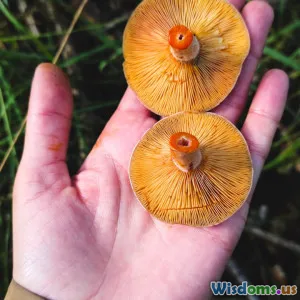
The Joy of Wild Food Adventure
8 min read Explore the joy of wild food adventures and learn essential survival skills amidst nature's bounty. (0 Reviews)
The Joy of Wild Food Adventure
Introduction
In an age dominated by convenience and bustling cities, the thought of venturing into the wild to forage for food can feel both liberating and intimidating. However, the art of wild food adventure is not merely about survival; it intertwines the thrill of exploration, the joy of discovery, and the satisfaction of connecting deeply with our environment. Imagine identifying a wild patch of berries or a cluster of mushrooms and knowing how to responsibly harvest them. This journey into nature offers both culinary excitement and a vital skill set that can enrich our lives.
Why Wild Food Adventures?
The Connection with Nature
Eating is an integral part of our lives, yet seldom do most individuals consider where their food originates. Wild food adventures present an enticing opportunity to reconnect with nature and develop a more intimate understanding of the ecosystem. "Foraging allows you to see food as not just a commodity, but also as a living part of the ecosystem," states wild food enthusiast and author, Sam Thayer. This deeper connection fosters not only appreciation but a respect for the environment necessary for its preservation.
Nutrition and Sustainability
Wild plants often contain more nutrients than domesticated varieties. For instance, stinging nettles, an often-overlooked weed, are incredibly nutrient-dense, packed with vitamins A, C, K, and several B vitamins, as well as minerals like iron and calcium. By engaging in wild food adventures, we embrace not only healthier eating habits but also sustainable living. Gathering food from the wild minimizes our carbon footprint while promoting biodiversity by interacting harmoniously with local ecosystems.
Basic Foraging Skills
Identifying Edible Plants
For beginners, understanding plant identification is paramount for successful foraging. A few essential tips include:
- Learn the Basics: Familiarize yourself with the most common edible plants in your area such as dandelion greens, lamb's quarters, and wild garlic. Local foraging books and online resources can be invaluable.
- Use Apps: Many modern foragers rely on mobile applications like PlantSnap or PictureThis, which help identify plants through image recognition.
- Practice Caution: Understand the concept of “look-alikes,” which can pose a danger if misidentified. For example, the poison ivy plant bears similarity to edible plants like wild strawberries, so proper learning is essential.
Responsible Foraging
to enjoy it while protecting the environment for future generations. Key principles include:
- Sustainable Harvesting: Only take what you need, ensuring plenty is left for wildlife. Examples include picking berries by hand but leaving some-of the bush untouched.
- Know Local Laws: Not all lands are open to foraging, so before heading out, familiarize yourself with land management policies.
Adventure in Foraging
Seasonal Foraging Basics
Different seasons unveil specific riches of nature. Spring tends to be generous with young greens, like ramps and wild leeks. In summer, you might find a bounty of fruits such as blackberries and elderberries. Autumn ushers in an array of mushrooms, but caution is essential lest you come across toxic varieties. Understanding these seasonal patterns enriches your wild food adventure.
Connecting with the Community
For many, wild food adventures spark communal excitement. Engaging with fellow foragers opens doors to new knowledge, shared experiences, and collective adventures. Facebook groups or local workshops are excellent venues for finding people who share your passion. In addition, attending events like wild food potlucks showcases various dishes made from foraged foods. Sample nettle soup, wild berry muffins, or even wild herb pesto!
Safety Considerations
Potential Risks and Precautions
While foraging offers many benefits, it's imperative to remain conscious of certain hazards. The following considerations keep your adventure enjoyable and safe:
- Allergies: Always perform a sensitivity test, especially on plants you have never consumed before.
- Contaminated Areas: Avoid foraging in polluted locations, like roadsides or near industrial sites, where toxins may linger.
- Wild Animal Caution: Anticipate encounters with wildlife. Understanding local fauna and their territories can mitigate surprise encounters.
Recipes for Wild Foods
If you've ventured into the woods and returned with a harvest, knowing how to prepare these wild finds makes the adventure complete. Here are a couple of concise recipes:
Wild Garlic Pesto:
Ingredients:
- 2 cups of wild garlic leaves
- 1/2 cup of nuts (pine nuts or walnuts work well)
- 1/2 cup of olive oil
- Salt and pepper to taste
Instructions:
- Blend together the wild garlic and nuts in a food processor until coarsely ground.
- Gradually add olive oil while blending until you reach the desired consistency.
- Season with salt and pepper. Enjoy with pasta or on toast!
Blackberry Crisp:
Ingredients:
- 2 cups of blackberries (wild harvested)
- 1 cup rolled oats
- 1/2 cup flour
- 1/4 cup sugar
- 1/2 cup butter, melted
Instructions:
- Preheat the oven to 350°F (175°C).
- In a bowl, mix blackberries with 2 tablespoons of sugar. Place in a baking dish.
- In another bowl, combine oats, flour, the remaining sugar, and melted butter. Use fingers to crumble this mixture over the blackberries.
- Bake for about 30 minutes or until the crisp top is golden.
Conclusion
The joy of wild food adventure transcends mere sustenance. It fosters a bond with the natural world, developing awareness, respect, and appreciation for our surroundings. Unlocking the secrets of edible plants turns foraging into a powerful survival skill, enabling us to venture beyond our comfort zones. Next time you find yourself in nature, take a moment to question whether these plants around you could be a part of your next meal – and embark on an adventure that feeds not only your body but also your spirit.
Rate the Post
User Reviews
Popular Posts





















